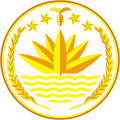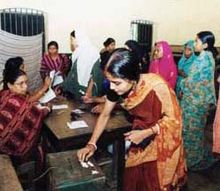
Back বাংলাদেশে নির্বাচন Bengali/Bangla Εκλογές στο Μπανγκλαντές Greek انتخابات در بنگلادش Persian Élections au Bangladesh French
| This article is part of a series on the |
| Politics of Bangladesh |
|---|
 |
|
|
|
|

Bangladesh elects on national level a legislature with one house or chamber. The unicameral Jatiyo Sangshad, meaning national parliament, has 350 members of which 300 members are directly elected through a national election for a five-year term in single-seat constituencies while 50 memberships are reserved for the women who are selected by the ruling party or coalition. The Prime Minister is the head of the government. The president who is the head of the state is elected by the National Parliament. The president of Bangladesh is a ceremonial post and does not exercise any control over the running of the state.
Bangladesh has an unofficial two-party system which has evolved over time since the election of 1991. It means that there are two dominant political parties or coalitions, one headed by Bangladesh Awami League and the other by Bangladesh Nationalist Party, with extreme difficulty for anybody to achieve electoral success under the banner of any other party in terms of achieving a majority. However, the Jatiya Party (Ershad) also has gained electoral success over the years, winning several local and mayoral elections and being the primary opposition party since 2014 following the boycott of BNP.


